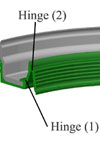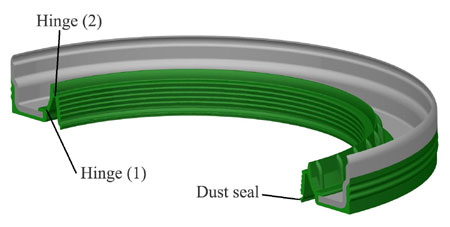Crank seal revolutions
 If you thought it was only race engine manufacturers who are paranoid about friction at the crankshaft seal, think again. The inexorable push towards ever lower CO2 emissions - better fuel economy to you and me - is making many an original equipment (OE) engine component supplier look much more closely at its products.
If you thought it was only race engine manufacturers who are paranoid about friction at the crankshaft seal, think again. The inexorable push towards ever lower CO2 emissions - better fuel economy to you and me - is making many an original equipment (OE) engine component supplier look much more closely at its products.
Chief among these is Federal-Mogul, which has just introduced a 'new approach' to lip seal technology, claiming that it reduces friction by up to 70% compared with conventional technology. Although a slightly revised version of its own-developed fluoroelastomer has been used, friction is solely the result of a new 'dual hinge' concept that ensures the seal tip can more faithfully follow the contours of the shaft at speeds of up to 8,000 rpm.
Larry Brouwer, director of sealing technology and innovation at Federal-Mogul Powertrain Sealing and Bearings, explains, "There are currently two types of seal types for light-duty use. The first uses a sprung elastomer with a helical spring holding the lip against the shaft, while the second is a 'laydown' type seal." The laydown type is favoured in Europe and its construction produces a much lower sealing pressure on the shaft. Already a low-friction component, it is to this latter type that the 'duel hinge' concept applies.
These two hinges are, first, at the point where the elastomer (shown in green in the graphic here) moves away from the steel backing and, second, at the 'U' bend where the elastomer turns back towards the fluted section. The fluted section in the diagram is the scroll, which returns any excess oil that may have reached the outer part of the seal, back to the sump.
In any rotating seal design it is imperative that the lip of the seal conforms to the shape and position of the surface of the journal at all times. Thus the out-of-roundness of the journal, the clearance between journal and bearing, and a host of minor manufacturing imperfections, all have to be accommodated. In compensating for these it is tempting to have the seal grip 'tighter' but as we know this leads to friction and heat - the biggest enemy of all.
So the real task of the designer is to accommodate all these with the minimum of friction but without compromising its performance as a seal. And while all this is difficult enough, the greatest challenge is to accomplish it at high engine speeds. At such speeds the hysteresis in the elastomer is likely to encourage seal and shaft to part company, as well as encourage higher temperatures that can carbonise the oil, forming ash in a critical area. If it's left in place for long this ash will act as a form of grinding paste and quickly destroy both the seal lip and crank surface finish.

But in optimising the friction in the oil seal it would be easy to forget that the same has to be done for the outer dust seal, since although its function is slightly different, the same issues apply. And just like a design of which our race engine designer would be proud, all this has been packaged such that it needs only 5mm of axial space on the crankshaft.
To get to this point, the latest in finite element techniques has been adopted and, using a sophisticated 'design of experiments' approach together with a compliment of 25 different tests, seal friction, according to the company is now probably about as low as it can get.
And when you think that a single drop of oil in 150,000 miles would constitute a component failure, the stakes are pretty high. Often we're so used to thinking that motorsports has the greatest challenge but with the push towards ever greater fuel economy, road transport could be seen to be leading the way here.
Fig. 1 - Crank seal
Written by John Coxon